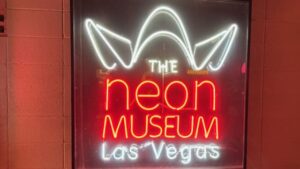
I have been going to Las Vegas for about 35 years and was back last week. The Strip has changed markedly in that time. Hotel/casinos have disappeared after being imploded — The Tropicana is the most recent. New resorts have taken their place, although there are still large tracts of land that have not been re-developed.
There was a time when you could walk down the middle of The Strip and see free entertainment from the sidewalk. Treasure Island had two pirate ships in a lagoon battling each other with pyrotechnics and sword play. At some point, the pirates on one of the ships were replaced by scantily clad sirens enticing the men on the other boat to come over and, well, this was an open-air show that attracted families with kids, so the only thing going on was some mild grinding while singing and dancing. Though Treasure Island is still there, the boat battles ended in 2013.
Next door was the Mirage, which had a volcano in front blowing its top every hour. There was no lava, but plenty of spraying water and bursts of fire. It drew a crowd, too, but it was never clear to me how many pedestrians viewed these sidewalk shows and then went into the casino to lose money. It must have worked for a while, because those productions lasted for years, but the new owners of the Mirage are turning it into a Hard Rock Hotel. In the process, they’ve torn down the volcano and will replace it with a guitar hotel akin to its sister resorts in Tampa and Hollywood, Florida. It was strange to walk by there last week and see the place surrounded by fences and construction equipment.
That leaves the dancing fountains in front of the Bellagio as the only free entertainment on The Strip. Unfortunately, the view from the sidewalk is currently blocked by grandstands erected for an F1 auto race, which will return next month. I spoke to several cabbies and Lyft drivers who said that F1’s Las Vegas debut last year was not good for them or other locals. Not only did it create massive traffic jams on The Strip, but the crowd F1 attracts is mostly wealthy Europeans who pay big bucks to attend, but stick to their hotel/casinos and their viewpoints for the race. Because of that experience, the drivers rode with told me they will they will stay home, because those visitors won’t go anywhere around town, so it makes no sense to get stuck with no passengers to transport.
The good news is you can still see the Bellagio fountains from the other side of the lake — in front of the hotel/casino’s main entrance — and the display is still mesmerizing. It only lasts 7-8 minutes, but I always get a kick out of it. And I still love the Chihuly glass covering the ceiling of the lobby.
If you want to see Las Vegas history up close, I recommend visiting the Neon Museum, home to a lot of signs which adorned businesses of the past. I’ve been there before, but this time I went at night, when quite a few of the signs were lit, and our tour guide (Randy) told some interesting and funny stories about them. I also learned that not all of those glass tubes contain neon because that gas only glows orange or red. In order to get blue, yellow, or green, the tubes need argon, and he pointed them out as we walked along.
It’s always cool to see the original signs from Binion’s Horseshoe, The Riviera (the first place I stayed in Vegas, which I wrote about here), the Stardust (which I wrote about here), the Moulin Rouge (the first fully integrated hotel in Las Vegas), and several non-casino outlets — including a dry cleaner whose sign featured a dancing shirt.
Another sign Randy told us about once stood outside the Silver Slipper, which was known for its burlesque shows and very late night entertainment. Coincidentally, my friend Mark Evanier wrote about the place on his blog a couple of days ago. But one thing he didn’t mention is that the original giant slipper that sat atop the big sign is now located on a lamppost in front of the museum — and its many bulbs are lit at night, too.
The other place I went back to — because I wanted to show it to my friend Bill — was the Pinball Hall Of Fame. It’s essentially a warehouse full of vintage pinball machines, video games, skee ball alleys, and the like. There’s no admission, but there are change machines so visitors can get quarters and play. Just walking up and down the aisles we got nostalgic, remembering some of them from our youth and marveling at the ones designed to as cross-promotions for movies, TV shows, and cereals (!). We also tried out some old baseball machines where one player chooses what kind of pitch will come up from under a metal rectangle in the middle of the diamond while the other hits a button that makes the bat swing, hopefully sending the ball to the spots along the far wall where it becomes a base hit, an out, or — if you’re really skilled — a home run.
Neither of us managed that. In fact, as we played, we realized how much we’ve lost the flipper dexterity and reaction timing we had as kids. And we still got just as frustrated when the balls went down the hole and out of play.
The Pinball HOF doesn’t charge admission and is run by volunteer enthusiasts who know the history of the games and spend a lot of time repairing them. One volunteer told us the place donated $1.2 million to charities last year. That’s a lot of quarters, and we were happy to contribute ours.
